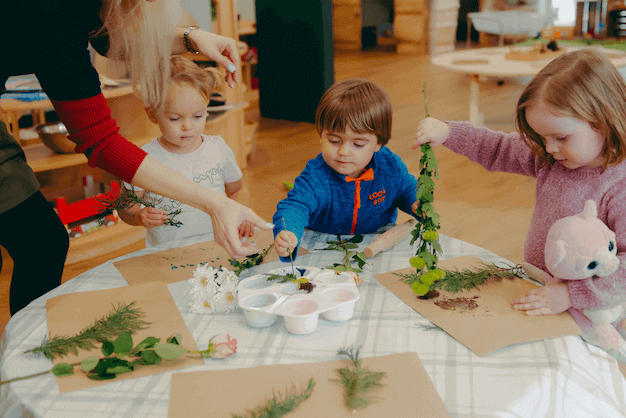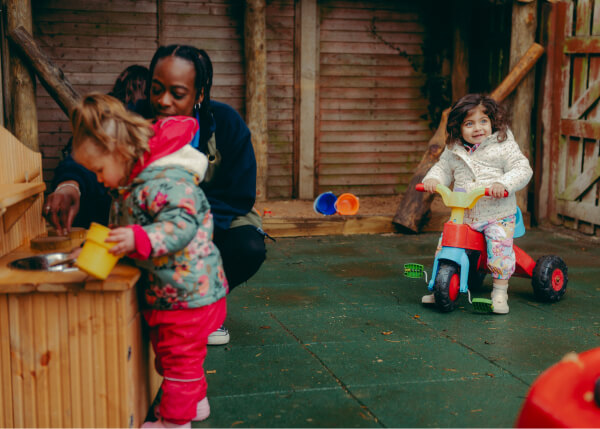The six areas of learning in early years form the foundation of a child’s development and are central to the Early Years Foundation Stage (EYFS) curriculum in the UK. These include Personal, Social and Emotional Development, Communication and Language, Physical Development, Literacy; Mathematics, Understanding the World and Expressive Arts and Design.
These key areas guide how nurseries, preschools and early years settings plan play-based activities, ensure a balanced early education and nurture skills that prepare children for school and beyond. A recent report from the Department for Education revealed that over 90% of 3 and 4 year olds in England attend settings following the EYFS framework, highlighting its universal importance.

What Is Personal, Social And Emotional Development?
Personal, Social and Emotional Development focuses on a child’s ability to form positive relationships, develop self-confidence and manage emotions. Within this area, children are encouraged to share, take turns and resolve conflicts in a supportive environment. This helps establish positive habits, such as empathy and emotional resilience, before starting school.
What Is Communication And Language?
Communication and Language development refers to how children learn to listen, understand and speak. Settings nurture this through stories, conversations, rhymes and singing, gradually building vocabulary and encouraging expressive language. Effective early communication skills underpin later literacy development and contribute to a child’s ability to engage with peers and adults.
What Is Physical Development?
Physical Development involves both gross and fine motor skills, as well as understanding the importance of movement and health. Activities extend from climbing and running to threading beads or using scissors. Encouraging regular physical activity contributes to children’s overall wellbeing and helps them gain control and coordination.
What Is Literacy?
Literacy in the early years encourages children to recognise sounds and letters, as well as explore reading and writing in meaningful ways. Practitioners provide a range of reading materials, from simple picture books to sensory story sessions, offering opportunities for mark-making through drawing and writing.
This foundational literacy learning fosters a love of stories and supports reading readiness for later education.
What Is Mathematics?
Mathematical development introduces children to counting, recognising numerals, exploring shapes and using concepts such as size and pattern. Through everyday play, like sorting by colour or measuring sand and water, children experience maths in a fun and practical way.
Mathematics learning in early years sets the scene for future numeracy skills and helps children gain confidence in using numbers in everyday contexts.
What Is Understanding The World?
Understanding the World encourages children to explore people, places, technology and the natural environment. Activities might include planting seeds, examining insects, using age-appropriate technology or discovering landmarks and cultural celebrations. This area helps children make sense of their surroundings and begin to understand diversity within their community.
What Is Expressive Arts And Design?
Expressive Arts and Design covers creative development, including art, music, dance and imaginative play. Children are provided with tools such as paints, play dough, musical instruments and dress-up clothes to express ideas and emotions. Engaging in creative activities encourages originality, concentration and self-expression, essential for a well-rounded early learning experience.
How Do The Six Areas Of Learning Interconnect?
Although the six areas of learning are distinct, in practice they overlap and support one another. When children are engaged in outdoor play, for example, they may exercise physical development by climbing, communication and language through conversation with friends, and understanding the world by observing wildlife.
This integrated play-based learning approach is central to effective early years provision.

Why Are These Areas Important?
The EYFS framework uses the six areas of learning to ensure children receive a balanced and comprehensive educational experience. By focusing on multiple aspects of development, social, emotional, cognitive, physical and creative, settings prepare children not only for academic success but also for life skills in communication, problem-solving, self-regulation and relationships.
Statistics show that settings using a well-rounded curriculum see improvements in children’s school readiness, with nearly 85% meeting early development milestones by the age of 5 years old.
How Do Settings Use The Six Areas Of Learning?
Nurseries and preschools embed the six areas of learning in daily routines, from circle time and guided activities to free play and focused group sessions. Practitioners observe each child’s progress and tailor activities to support their stage of development, ensuring interventions in areas requiring additional support.
Learning is documented in portfolios and shared with parents to involve them in their child’s journey.
What Role Do Parents Play?
Parents are key partners in applying the six areas of learning at home. Reading together supports literacy and communication skills.
Outdoor walks and simple cooking activities at home can reinforce understanding of the world, mathematics and physical development. Building a positive home-learning environment strengthens children’s early progress and curiosity.
What Is Next After The Early Years Curriculum?
Children who have experienced a rich early years curriculum move into primary school ready to build on the foundation set by the six areas of learning. Strong skills in communication, confidence, number sense and creativity help smooth the transition to Reception class and beyond.
The Bottom Line
Nurseries like Jack & Jill’s in Hemel Hempstead ensure the six areas of learning remain central to everything they do. Through indoor and outdoor activities, including play and creative sessions, practitioners support each child’s development holistically. This breadth of approach ensures every child is guided toward their next stage with confidence and curiosity.
For parents exploring early years settings, asking how each nursery supports the six areas of learning is a helpful starting point. By choosing a setting aligned with the EYFS principles, families can ensure their child receives a solid foundation in learning and development.